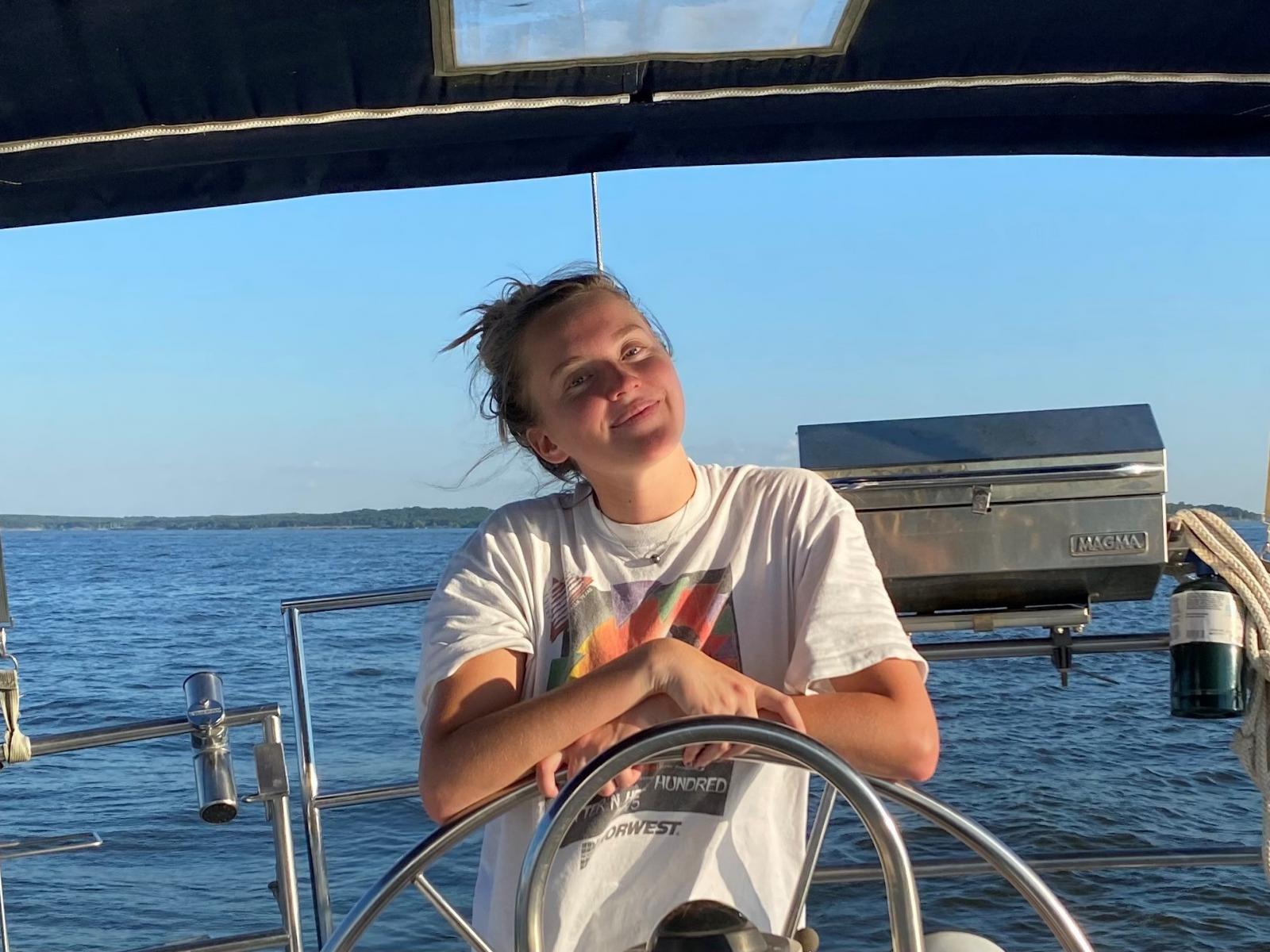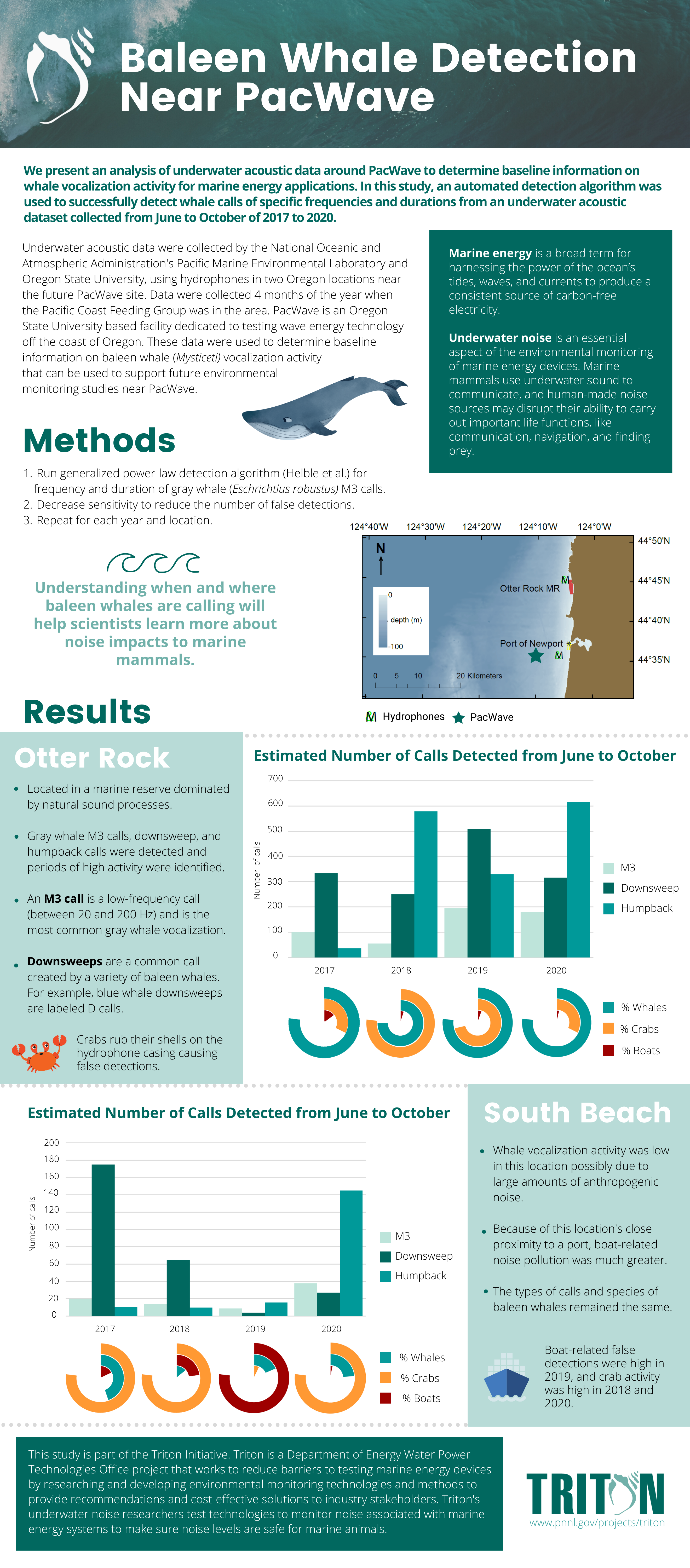The Perspectives of a Triton Intern with Christa Hvidsten

Photo courtesy of Christen Hvidsten
I am Christa Hvidsten, and I'm taking over this month's Triton Story to share my experience as an intern in the Department of Energy (DOE) Student Undergraduate Laboratory Intern (SULI) program for the Triton Initiative at Pacific Northwest National Laboratory (PNNL). I study ocean engineering at Texas A&M University at the Galveston campus and have a passion for marine energy and the environment. This past summer, I had the opportunity to apply my engineering skills toward an underwater acoustics project and develop key science communication skills along the way.
From sailing to ocean engineering
I grew up sailing from a young age. These experiences traveling by boat with nothing but wind in its sails and waves rolling beneath it grew into a passion for the ocean. I have always had questions about marine environments and the power the sea holds. As we look to renewable energy sources, I often wonder—how can the energy of the ocean power communities? As an aspiring engineer, I knew that I wanted to help find a safe and sustainable way to extract this power. These curiosities led me to learn about marine energy and pursue an undergraduate degree in ocean engineering. While studying at Texas A&M University, I was able to choose between studying at the College Station or Galveston Island campus. Naturally, as a salty explorer, I decided to live on the island. Throughout my time in college, I worked as a laboratory assistant for the ocean engineering department and volunteered with Engineers without Borders. These experiences allowed me to learn about different projects in the ocean engineering department and taught me ways to utilize my skills from the classroom to help make the community-scale change that benefits humans and the ocean. Yet, I've had few opportunities to work directly with marine energy projects due to the lack of marine energy devices in U.S. waters.
On my quest to learn more about marine energy technologies, I discovered the research conducted at PNNL. I applied for the SULI internship, which led me to the Triton Initiative. Triton is a DOE Water Power Technologies Office project dedicated to understanding environmental monitoring technologies and methods for collecting data necessary to understand the impacts of marine energy devices. The project researches and develops environmental monitoring technologies and techniques, which require ocean engineers and people with the same curiosities as me. I was thrilled to have the opportunity to work with a team of scientists and engineers to make a future for marine energy installations possible. After receiving my acceptance for the internship to work with Triton, my first day on the job couldn't have come sooner.
Supporting underwater noise research
My project work with Triton primarily focused on the Triton Field Trials underwater noise stressor research. Marine wildlife species use acoustic signals for various essential life functions, such as foraging, navigation, and reproduction. Changes to the soundscape in their environment may affect their feeding, reproductive, resting, and migration patterns. Triton works to determine the best methods to measure the frequencies and levels of marine-energy-associated sound and study how those noise levels may affect animals in the marine environment.
Specifically, my research detected and characterized baleen whale vocalization activity near the future PacWave test site in Newport, Oregon. PacWave is a DOE-funded facility based out of Oregon State University (OSU) dedicated to testing and monitoring wave energy converter devices. For this work, I focused on vocalizations of gray whales (Eschrichtius robustus), known to migrate and feed in shallow coastal waters. These habitat preferences expose them to elevated ambient noise levels from anthropogenic sounds, such as boats, moorings, and other human-caused sounds. The data were collected by the National Oceanic and Atmospheric Administration’s (NOAA’s) Pacific Marine Environmental Laboratory using two OSU-NOAA hydrophones placed near the future PacWave facility. One hydrophone was deployed in the Otter Rock Marine Reserve, an area dominated by natural sound processes, while the other was placed off South Beach in an area with heavy vessel traffic near the Port of Newport.
I created a set of parameters specific to the frequency range and duration of gray whale M3 calls identified in the datasets to detect the vocalizations. I adjusted the sensitivity to anthropogenic noises present in the data to reduce false detections. M3 calls are the most common vocalization produced by gray whales in the northeast Pacific, with a peak frequency of less than 100 Hz. Downsweep and humpback whale calls were also detected and identified in the data using these parameters. Downsweeps are a vocalization made by various baleen whales (e.g., blue whales, sei whales) and have a frequency that decreases with time. Humpback whales produce a variety of calls and are one of the more vocally active baleen whales. I manually verified the baleen whale calls detected using a spectral analysis software called RavenPro™ from Cornell University. Because the marine soundscape is filled with natural, biological, and human-caused sounds, it's essential to be able to isolate the sounds whales produce so we can better understand how device-derived noise is interfering with those frequencies. We found three leading causes of false detections: crab activity on the hydrophone casing, boat-related noise, and ambient noise caused by wind and waves.
My project showed a significant difference in the detection rates of baleen whale vocalizations between the two locations: Otter Rock had a greater amount of whale vocalizations detected, whereas South Beach had more false detections with less whale activity detected. This result highlighted the difference between the two soundscapes and the potential influence of ambient conditions on detecting whale vocalization activity in these areas. I also identified vocalization trends over the four years and determined times of high vocalization activity for each whale call, which helps us understand when whales are present in deployment areas. Gray whale M3 calls and downsweeps were consistently found in high numbers during July and August at both sites, and humpback calls were detected in large volumes throughout September and early October.
This whale vocalization information helps researchers understand whale activity in the region and track changes in marine mammal activity before and after deployment of wave energy converters at PacWave, once the site becomes operational. Utilizing tools like automated detection algorithms allows scientists to quickly analyze large datasets and accurately determine the vocalization patterns and habits of the animals inhabiting an area. These methods decrease the time and cost of environmental monitoring for regulation and policy efforts for marine energy devices. This work will help the industry better understand the potential underwater noise effects on marine mammals and deploy safe and sustainable renewable energy solutions.
For more information, check out the infographic I made to summarize my results!

The SULI intern perspective
Joining this project, I wasn't an expert on underwater noise or passive acoustic analysis. While I had previous knowledge of ocean wave mechanics from my ocean engineering classes, I was challenged to apply that information to underwater acoustic wave data. This led to a cascade of questions for the underwater noise research task lead, Joe Haxel, and team. I worked with various scientists with different expertise, learning from their experiences and searching for answers to my endless questions. This was how the team functioned; Triton's many scientists constantly asked questions, worked through challenges, and explored new ideas, together. Soon I realized that science is a big collaboration effort, where people with unique specialties come together to find answers to the world's most challenging questions. It's valuable to see collaborative science in action. Not only is there internal collaboration, but outside organizations and scientists also work to help Triton serve its mission. Learning about the power of collaborative science was one of my most significant takeaways from this experience.
This internship also provided me an opportunity to jump into the world of science communication. I worked with Cailene Gunn, the lead for the Triton Initiative's communication, outreach, and engagement effort, to learn the ins and outs of what it takes to effectively communicate research to broad audiences. I gained experience developing creative communications content, like an infographic, presentation, and social media posts. Part of this experience involved sharing my story with audiences like you through this Triton Story. The Triton Stories are so important because telling researchers' science stories creates opportunities to inspire someone's science journey. I think it's particularly beneficial to hear from interns because we're still finding our path in science, and these types of experiences like this SULI internship help encourage others to find their way. I hope this story shows that internships in renewable energy exist, and there are opportunities for students to work with teams conducting meaningful research that help forge a path to a future with clean energy. Sharing my story helped me realize that science communication is needed to connect scientists and their research to different audiences. It helps bridge the gap between the scientific process and the audience.
Thank you to my mentors, Alicia Amerson and Joe Haxel, for your guidance, knowledge, and support throughout my time as an intern and for introducing me to the wonderful Triton team. Thank you to Cailene Gunn for teaching me how to communicate my research and experiences. And a big thank you to the Triton team for giving me a summer internship experience I'll never forget.
Story written by Christa Hvidsten
Subscribe to our monthly newsletter here.
Published: October 5, 2021